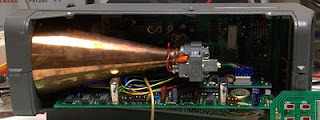as you see here, the ionization is almost complete with alumminum lead, but there's still the alpha particles.which needs therefore this gunn diode for emission of negative frequencies

The negative differential resistance, combined with the timing properties of the intermediate layer, is responsible for the diode's largest use: in electronic oscillators at microwave frequencies and above. A relaxation oscillator can be created simply by applying a DC voltage to bias the device into its negative resistance region. In effect, the negative differential resistance of the diode cancels the positive resistance of the load circuit, thus creating a circuit with zero differential resistance, which will produce spontaneous oscillations. The oscillation frequency is determined partly by the properties of the middle diode layer, but can be tuned by external factors. In practical oscillators an electronic resonator is usually added to control frequency, in the form of a waveguide, microwave cavity or YIG sphere. The diode is usually mounted inside the cavity. The diode cancels the loss resistance of the resonator, so it produces oscillations at itsresonant frequency. The frequency can be tuned mechanically, by adjusting the size of the cavity, or in case of YIG spheres by changing the magnetic field. Gunn diodes are used to build oscillators in the 10 GHz to high (THz) frequency range.
Gallium arsenide Gunn diodes are made for frequencies up to 200 GHz, gallium nitride materials can reach up to 3 terahertz.[





No comments:
Post a Comment